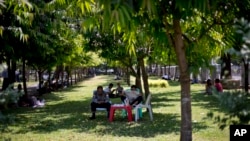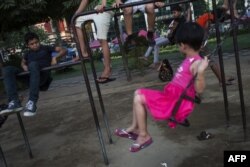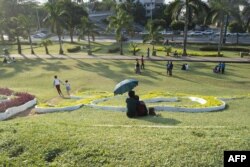Khin Khin Htay lives with her family in Yangon's sprawling northern outskirts. She recently traveled with her two young daughters by bus to a park in the center of the city. The journey took at least one-and-a-half hours each way, but Khin Khin Htay said it was worth it.
"My daughters really like coming here. Where we live, there is no public space, so we travel all this way," she told VOA, as her daughters played on the swings behind her.
Public space is somewhat of a rarity in Myanmar's former capital, and residents are concerned that as more commercial projects go online, the limited space that is available will gradually disappear.
Yangon has one of the lowest public space per capita ratios for a major world city. A 2014 study conducted by the Yangon Technological University said Yangon has 0.37 square meters of park space for each head of population. In contrast, Jakarta has 6 square kilometers; Bangkok 8.5 square kilometers; and Paris 30 square kilometers.
Moe Moe Lwin, director of Yangon Heritage Trust, said Yangon has more than 607 hectares of parkland, but many of the parks are "inaccessible to the public."
"Improving access to spaces or developing enough public spaces for fitness or relaxation or cultural activities has various social, economic and health benefits for Yangon and its residents," she told VOA, adding that public space has shrunk in Yangon in recent years, mainly due to mismanagement, commercial development and a lack of legal measures for protection.
A representative for the Yangon City Development Committee, the city's municipal body, could not be reached for comment.
A place to relax
Some private organizations are working with local authorities to try to open more public space in the city. These include Doh Eain, which was founded in 2017.
Founder Emilie Röell said she established the organization after she noticed many of Yangon's unique heritage buildings and public spaces were quickly having to make way for new construction projects.
Röell said the organization hoped to deliver more and better designed public spaces in Yangon, including parks, pedestrian areas and playgrounds. She said an important component of Doh Eain's work was working closely with local residents to ensure they have a say in their city's future.
Their efforts include renovating some of downtown Yangon's alleyways. Many alleyways, particularly those in the dense downtown area, are used by residents to dispose of garbage, often leading to huge piles of trash which make the spaces unusable.
Doh Eain is currently involved in the renovation of six alleyways in the downtown area. Working closely with local residents, the projects involve cleaning the streets, painting walls in bright colors and providing facilities such as garbage bins, swings and benches.
"We noticed how busy the downtown area is, lacking places where one can take refuge from traffic to relax, sit together and play," said Röell. "We also noticed how there are many underutilized and dirty back lanes everywhere, which in various other cities in the world have started to be transformed into community and public spaces."
Opening an historic building
After decades of being closed off to the public, one of the country's most important buildings is gradually opening up. The Secretariat, a sprawling red-brick structure in the heart of the city, is significant for Myanmar's people, as it was where Aung San, independence hero and father of Aung San Suu Kyi, was assassinated alongside members of his Cabinet in 1947, months before Burma gained independence from the British.
In 2014, on the anniversary of the killings remembered as Martyrs' Day every July 19, the public was allowed to enter the compound for the first time. The event has grown in popularity every year, and now a company renovating the building, the Anawmar Group, has allowed an art space called Pyinsa Rasa to be opened in one wing of the building. The exhibition space is expected to stay there until July.
Nathalie Johnston, co-founder of Pyinsa Rasa, said the idea behind the project was to showcase how it can be used as a space for the public, but also to help people understand it also needs to be commercially viable.
"The building is important here, and people in Yangon feel they should own this building," Johnston told VOA. "But how do you pay for this? ... So, I think it's about finding the go-between so that people can appreciate, yes heritage is important and history is important, but you also need money to pay for it."
VOA's Sa Len Ai contributed to this report.










